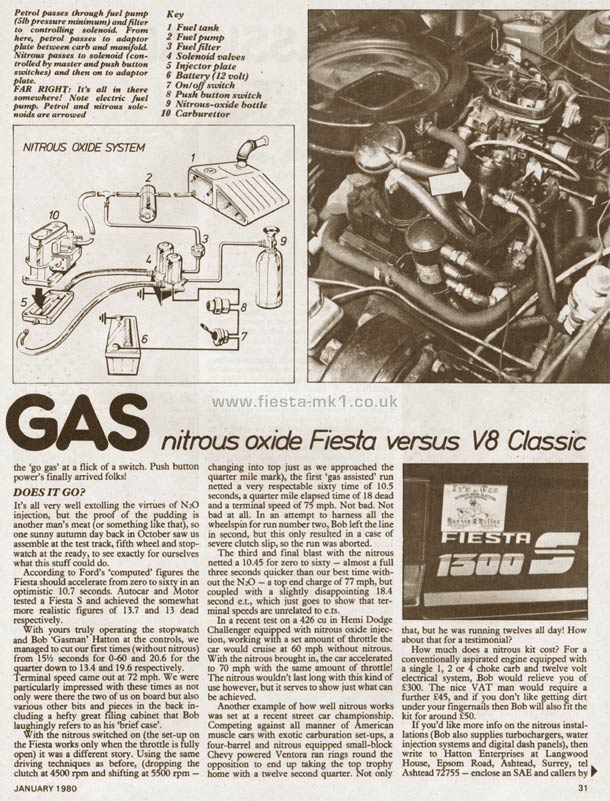Copy of Article Text Below
.....the 'go gas' at a flick of a switch. Push button power's finally arrived folks!
DOES IT GO?
It's all very well extolling the virtues of N²O injection, but the proof of the pudding is another man's meat (or something like that), so one sunny autumn day back in October saw us assemble at the test track, fifth wheel and stopwatch at the ready, to see exactly for ourselves what this stuff could do.
According to Ford's 'computed' figures the Fiesta should accelerate from zero to sixty in an optimistic 10.7 seconds. Autocar and Motor tested a Fiesta S and achieved the somewhat more realistic figures of 13.7 and 13 dead respectively.
With yours truly operating the stopwatch and Bob 'Gasman' Hatton at the controls, we managed to cut our first times (without nitrous) from 15'/2 seconds for 0-60 and 20.6 for the quarter down to 13.4 and 19.6 respectively. Terminal speed came out at 72 mph. We were particularly impressed with these times as not only were there the two of us on board but also various other bits and pieces in the back including a hefty great filing cabinet that Bob laughingly refers to as his 'brief case".
With the nitrous switched on (the set-up on the Fiesta works only when the throttle is fully open) it was a different story. Using the same driving techniques as before, (dropping the clutch at 4500 rpm and shifting at 5500 rpm - changing into top just as we approached the quarter mile mark), the first 'gas assisted' run netted a very respectable sixty time of 10.5 seconds, a quarter mile elapsed time of 18 dead and a terminal speed of 75 mph. Not bad. Not bad at all. In an attempt to harness all the wheelspin for run number two, Bob left the line in second, but this only resulted in a case of severe clutch slip, so the run was aborted.
The third and final blast with the nitrous netted a 10.45 for zero to sixty - almost a full three seconds quicker than our best time without the NzO - a top end charge of 77 mph, but coupled with a slighdy disappointing 18.4 second e.t., which just goes to show that terminal speeds are unrelated to e.ts.
In a recent test on a 426 cu in Hemi Dodge Challenger equipped with nitrous oxide injection, working with a set amount of throttle the car would cruise at 60 mph without nitrous. With the nitrous brought in, the car accelerated to 70 mph with the same amount of throttle! The nitrous wouldn't last long with this kind of use however, but it serves to show just what can be achieved.
Another example of how well nitrous works was set at a recent street car championship. Competing against all manner of American muscle cars with exotic carburation set-ups, a four-barrel and nitrous equipped small-block Chevy powered Ventora ran rings round the opposition to end up taking the top trophy home with a twelve second quarter. Not only that, but he was running twelves all day! How about that for a testimonial?
How much does a nitrous kit cost? For a conventionally aspirated engine equipped with a single 1, 2 or 4 choke carb and twelve volt electrical system, Bob would relieve you of £300. The nice VAT man would require a further £45, and if you don't like getting dirt under your fingernails then Bob will also fit the kit for around £50.
If you'd like more info on the nitrous installations (Bob also supplies turbochargers, water injection systems and digital dash panels), then write to Hatton Enterprises at Langwood House, Epsom Road, Ashtead, Surrey, tel. Ashtead 72755 - enclose an SAE and callers by.....
Captions -
Top-Left - Petrol passes through fuel pump (51b pressure minimum) and filter to controlling solenoid. From here, petrol passes to adaptor plate between carb and manifold. Nitrous passes to solenoid (controlled by master and push button switches) and then on to adaptor plate. FAR RIGHT: It's all in there somewhere! Note electric fuel pump. Petrol and nitrous solenoids are arrowed
|





